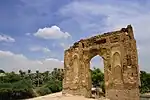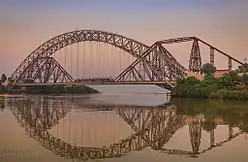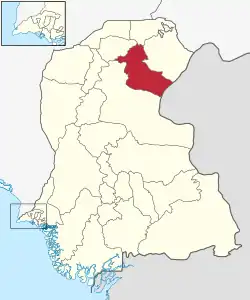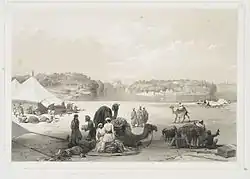Sukkur District
Sukkur District (Sindhi: سکر ضلعو, Urdu: ضلع سکّھر) is a district in Sindh Province in Pakistan. It is divided into 5 administrative townships (tehsils, also called "talukas"), namely: Sukkur City, New Sukkur, Rohri, Saleh Pat and Pano Aqil. Among them Sukkur City and New Sukkur are urban centres, while Pano Aqil is famous for having one of the largest military cantonments of the country. Rohri is the smallest tehsil of Sukkur District, both in area and population, but it has an important railway junction. Two districts have been split off from the territory of Sukkur: Shikarpur in 1977 and Ghotki in 1993.[3]
Sukkur District | |
|---|---|
| |
   .jpg.webp)  Clockwise from top-left: Sateen Jo Aastan, Mir Masum's Minar, Sadh Bela temple, Landsdowne Bridge, Muhammad Bin Qasim Masjid | |
 Map of Sindh with Sukkur District highlighted | |
| Coordinates: 27°40′N 69°30′E | |
| Country | |
| Province | |
| Division | Sukkur |
| Established | 1843 |
| Headquarters | Shikarpur 1843 to 1883 Sukkur 1883 to continue |
| Number of Tehsils | 5 |
| Government | |
| • Type | District Administration |
| • Deputy Commissioner | N/A |
| • District Police Officer | N/A |
| • District Health Officer | N/A |
| Area | |
| • Total | 5,165 km2 (1,994 sq mi) |
| Population (2017)[2] | |
| • Total | 1,488,372 |
| • Density | 290/km2 (750/sq mi) |
| Time zone | UTC+5 (PST) |
| Website | www |
Administrative subdivisions
| Tehsil | Population (2017) |
Area (km²) |
Union Councils |
Villages |
|---|---|---|---|---|
| Sukkur City | 231,589[4] | 150 | 11 | 25 |
| New Sukkur | 319,768[5] | 150 | 09 | 25 |
| Rohri | 371,104 | 1319 | 12 | 400 |
| Saleh Pat | 129,619 | 2339 | 03 | 250 |
| Pano Aqil | 435,823 | 1233 | 12 | 450 |
| Total | 1,487,903 | 5191 | 54 | 1150 |
History

The East India Company occupied Sindh in 1843; They formed three districts in Sindh administratively: Hyderabad, Karachi and Shikarpur.
In 1883 British Government shifted the district headquarter from Shikarpur to Sukkur and in 1901 again British Government shifted the district status from Shikarpur to Sukkur.
In 1904, the Pano Akil mahal was converted into a taluka of Sukkur District.[6]
At the time of Pakistan's independence in 1947, Sukkur district comprised approximately 200,000 inhabitants, mostly engaged in agricultural pursuits and fishing industry. Over time, Sukkur has seen a moderate rise in population (2 to 2.5% per annum) as compared to Pakistan's, except in late 1960s and early 70s when population growth rate reached 4.43% (1972 census) due to internal migration and establishment of some large bridges on river Indus.
.jpg.webp)
Sukkur district is chiefly populated by Muslims that constitute 96% of the total population. The minorities include: Hindus 3.28% and Christians about 0.51%. Hindus are mostly settled in urban areas and are engaged in the trade and services sectors. The independence of Pakistan in 1947 saw the influx of Muslims which include Urdu-speaking Muhajirs, Bandhani-speaking Rajputs from Rajasthan, Memons from Bombay, Gujarat and Kathiawar were migrated from India and settled here, mostly in the aftermath of riots when Pakistan was carved out of India as the result of Muslim vote; the Muslim population of India voted for their separate homeland, the Pakistan. While some of the Bandhani, Memons, and Punjabis were settled here before partition, i.e., the independence of Pakistan in 1947. Traditionally Memons were associated with trade and retail business but during last two decades they have ascended as an active social and economic front. Sukkur is noteworthy in Sindh and Pakistan generally for its comparative tolerance towards religious and ethnic minorities. City is a multi-ethnic and has a mix of Sindhis, Punjabis, Brahuis, Balochis and Pakhtuns. Sindhis are native to the area and speak its various dialects, including, Utradi, Lari, Thari, Dadhki, etc. A large number of Punjabis were attracted to the city after the Indus treaty settlement and are settled around the downtown and chowk Ghantaghar in central part of the city. Most Pakhtuns are distinct and separately living near the railway station and its vicinity. The city therefore has cosmopolitan atmosphere with multiethnic and multicultural communities.[7] Following are the demographic indicators of the district.
Demographics
| Year | Pop. | ±% p.a. |
|---|---|---|
| 1951 | 222,848 | — |
| 1961 | 277,356 | +2.21% |
| 1972 | 460,649 | +4.72% |
| 1981 | 575,962 | +2.51% |
| 1998 | 931,694 | +2.87% |
| 2017 | 1,488,372 | +2.50% |
| source:[8] | ||
At the time of the 2017 census, Sukkur district had a population of 1,488,372, of which 720,806 (48.43%) lived in urban areas. Sukkur had a sex ratio of 917 females per 1000 males and a literacy rate of 54.73%: 65.62% for males and 42.75% for females.[2]
| Religion | Population (1941)[9]: 54–57 | Percentage (1941) | Population (2017)[2] | Percentage (2017) |
|---|---|---|---|---|
| Islam |
185,249 | 63.46% | 1,430,376 | 96.10% |
| Hinduism |
102,072 | 34.97% | 52,902 | 3.55% |
| Sikhism |
3,794 | 1.30% | --- | --- |
| Others [lower-alpha 2] | 778 | 0.27% | 5,094 | 0.35% |
| Total Population | 291,893 | 100% | 1,488,372 | 100% |
The majority religion is Islam, with 96.10% of the population. Hinduism (including those from Scheduled Castes) is practiced by 3.55% of the population.[2]
At the time of the 2017 census, 83.63% of the population spoke Sindhi, 9.19% Urdu, 3.11% Punjabi, 1.39% Saraiki and 1.02% Pashto as their first language.[2]
List of Dehs
The following is a list of Sukkur District's dehs, organised by taluka:[10]
- City Sukkur Taluka (1 deh)
- New Sukkur
- New Sukkur Taluka (21 dehs)
- Abad Jagir
- Alif Katco
- Anghaho
- Arain
- Bagerji
- Belo Bagerji
- Belo Bindi
- Belo Shah Belo
- Belo9 Qadirpur
- Deda
- Dreha
- Farash
- Goseji
- Katcho Mando Dero Dero
- Mubrakpur
- Naseer Abad
- Old Sukkur
- Pacco Bindi Dhareja
- Rehuja
- Saeedabad
- Tanmachani
- Pano Aqil Taluka (96 dehs)
- Agro
- Aro
- Arrero
- Baghpai
- Bahman
- Baiji New
- Baiji Old
- Bakabad
- Belo Abad Malhani
- Belo Bahab
- Belo Hingoro
- Belo Khia Belo
- Belo Kotho
- Belo Qadir Dino
- Belo Sadhuja
- Belo Shah Belo
- Belo Shahpur
- Bhandki
- Bhullo
- Bilhani
- Bindi Tharachani
- Birth
- Bohi
- Budh
- Chanjani Chachar
- Chanjani Jatoi
- Chechero
- Dadloi
- Dandh Marhari
- Doghar
- Drib
- Erazi Sadiki
- Farakpur
- Gagni
- Gajaro
- Garkho
- Garwar
- Gharee
- Haleji
- Hasul
- Hingoro
- Hussain Beli
- Indharki
- Janaji
- Jhabero
- Jhan Khan
- Junas
- Katcho Kadirdino
- Katcho No. 1
- Katcho No. 2
- Katcho Qasimpur
- Katcho Shahpur
- Katta
- Khan Belo
- Kharaj
- Kot Sadik Shah
- Lanjari
- Lathwaro
- Liskani
- Machi
- Mangarki
- Meehoi
- Mian Kundho
- Miranpur Sadiki
- Mubarakpur
- Nangroro
- Naro Amul Hatti
- Naro Hamthar
- Nindapur
- Nirch
- Nouraja New
- Nouraja Old
- Nowlai
- Ochihar
- Pacco Bindi Shahpur
- Pano Aqil
- Pano Ghulam Ali
- Pano KharKhaso
- Panwari Jagir
- Panwari Rayaeti
- Qadirdino Bindi
- Roophar
- Sabni
- Sadhuja
- Salhani
- Sangi Kotai
- Sarai
- Shahpur
- Sorho
- Sugro
- Sultanpur
- Sunder Belo
- Talli
- Tarar
- Thikratho
- Ural
- Rohri Taluka (67 dehs)
- Abad
- Abejano
- Abra
- Akbarpur
- Allah Abad
- Arkohar
- Arore
- Begmanji
- Bhiro
- Boraha
- Bundtari
- Chak No. 2
- Chak No. 3
- Chak No. 4
- Cheel
- Dadah
- Dakhano
- Dalho
- Dhandhi
- Dodanko
- Dring Belo
- Dubarwahan
- Fakirabad
- Gatanwari
- Ghulam Goth
- Gidraro
- Hamanloi
- Hamanloi Jagir
- Hosho Shaheed
- Ibupota
- Jani Abad
- Jhangro
- Kalari
- Kalhori
- Kandhra
- Kandri
- Katcho Ali Wahan
- Katcho Mando Dero
- Katohar
- Katper
- Khadhari
- Khahi Jagir
- Khoori
- Kot Mir Yako
- Kotari
- Larh Jagir
- Mandodero
- Mangarki
- Mangria
- Mari
- Mari Janullah Shah
- Miani Bagat
- Nabi Shah
- Nandho Kohistan
- Panhwar
- Patni
- Ponath
- Rohri
- Saeedabad (Rohri)
- Sangrar
- Seerahi
- Subhanpur
- Tirore
- Trimoh Takar
- Trimoonh
- Umerkas
- Wado Kohistan
- Saleh Patt Taluka (87 dehs)
- Badal Fakeer
- Badeji
- Bago
- Bahadurio
- Bajar Waro
- Bargah
- Barro
- Beebai Daro
- Behan Wari
- Berrido
- Bitri
- Chak No. 5
- Chanareji
- Chogan Waro
- Chuganwari
- Chutto Khouh
- Dhulwaro
- Draban Waro
- Dubbo
- Dubi
- Gagro
- Gandaho
- Garang
- Garhar
- Goni
- Gurand
- Hussain Shah
- Ihsan Wari
- Januji
- Kanheja
- Kartar
- Khabar Waro
- Khabariro
- Khabri Bhit
- Khipro
- Khorore
- Khosanjo Kumb
- Khuni Khambharo
- Lairo
- Laiwari
- Lakhaji No. 1
- Lakhaji No. 2
- Looli Takar
- Lundi Bhit
- Lundiro
- Lundo
- Mahar
- Malaho
- Malik
- Mamro
- Manikwari
- Matto MAngrio
- Muhib Shah
- Murado
- Nihrad
- Panhwari
- Phat
- Phulokri
- Pir Buxji Bhit
- Pir Karo
- Rajar
- Registan Kartar
- Registan Mamro
- Rip
- Sadano
- Sadri
- Sahi Pat
- Sanghar
- Sanhari
- Sahnaro
- Setharo
- Shadmano
- Shah Nawaz Shah
- Siran Waro
- Soomarji
- Soonharo
- Sunhari Takar
- Tarai
- Thomi
- Tooryoun
- Udhar
- Ukri Takar
- Umerji
- Umerji Kandun
- Veenghko
- Viyari
- Wass
References
- PCO 1999, p. 1.
- "District-wise Tables - Sukkur". pbs.gov.pk. Pakistan Bureau of Statistics. 2017.
- PCO 1999, p. 11.
- "Pakistan: Tehsils and Talukas (Districts and Subdistricts) - Population Statistics, Charts and Map".
- "Pakistan: Tehsils and Talukas (Districts and Subdistricts) - Population Statistics, Charts and Map".
- "Pano Aqil Cantonment". www.globalsecurity.org. Retrieved 2023-08-13.
- Umair, Bisma (13 July 2013). "Sukkur".
- "Population of administrative units" (PDF). pbs.gov.pk. Pakistan Bureau of Statistics. 1998.
- "CENSUS OF INDIA, 1941 VOLUME XII SINDH PROVINCE".
- "List of Dehs in Sindh" (PDF). Sindh Zameen. Retrieved 22 March 2021.
Notes
- Pano Aqil, Rohri and Sukkur taluks of Sukkur district
- Including Jainism, Christianity, Buddhism, Zoroastrianism, Judaism, Ad-Dharmis, or not stated
Bibliography
- 1998 District census report of Sukkur. Census publication. Vol. 41. Islamabad: Population Census Organization, Statistics Division, Government of Pakistan. 1999.
